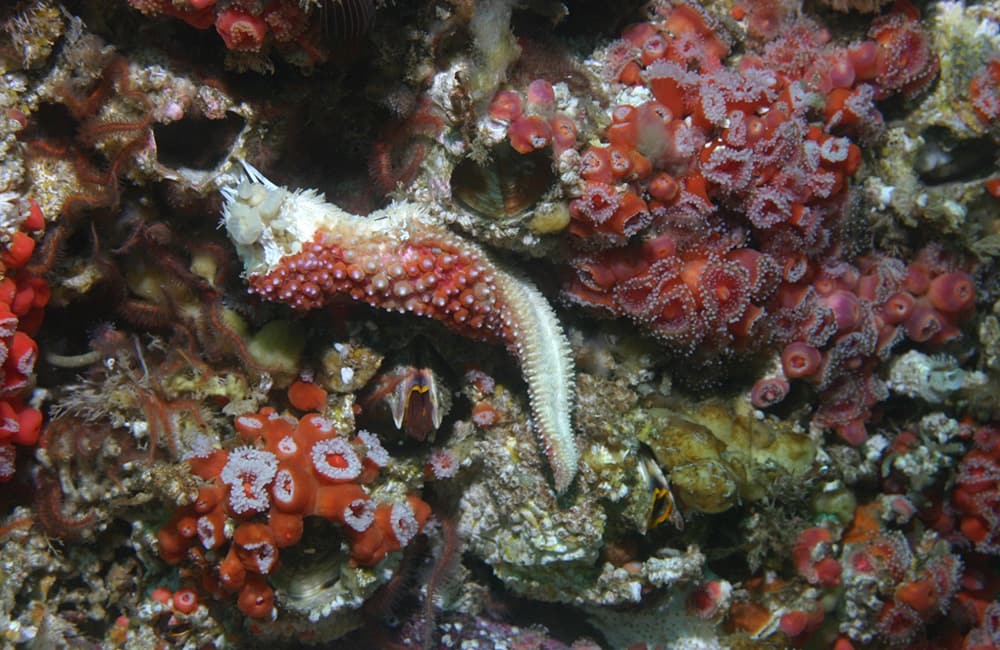Kelp in Decline

Kelp forests along the coastline of Sonoma and Mendocino counties have deteriorated dramatically in just a few short years. Greater Farallones National Marine Sanctuary has seen a series of compounding stressors that have led to extensive kelp declines in recent years, starting in 2014 (up to 95% in some regions) and loss of critical ecosystem function.
The Sea Star Wasting Syndrome led to the decline of 20 species of sea stars, including the sunflower star, a primary predator of urchins. The sunflower star was listed as critically endangered by the International Union for the Conservation of Nature (IUCN) in 2020.

A vast multi-year marine heatwave in the North Pacific was quickly followed by an exceptionally strong El Niño Southern Oscillation event during 2014-2016, creating unusually warm ocean conditions that limited nutrients essential for kelp growth.
These combined factors contributed to the rapid decline of bull kelp. A simultaneous boom in purple urchin populations led to exponentially increasing urchin populations, up to 60 times the historical average.

Hungry urchins grazed quickly through the remaining kelp stipes ("stems" that extend from the holdfast, the bottom of the kelp strand, up to 30 to 60 feet) and ate new algal growth on rocks. This urchin population boom with few predators to keep their population in check led to widespread and rapid decline of more than 90% of the kelp forest in some regions and an ecosystem shift to an 'urchin barren', or urchin-dominated conditions. Urchins can survive on extremely small amounts of food and are even able to shrink in size to reduce energy requirements, so their persistence continues to keep bull kelp from recovering. Urchin barrens can persist for years and even decades. Greater Farallones National Marine Sanctuary is working with a diverse group of experts to address this rapid loss of kelp. Through restoration efforts in Greater Farallones National Marine Sanctuary, we may be able to change the trajectory from urchin barren back to kelp forest.
Urchins and Kelp Forests
Very high densities of urchins that graze through algal growth is the main challenge that prevents kelp forest growth on the north coast. The primary strategy for kelp forest restoration is to remove urchins, or reduce their populations to give kelp space to grow. There are two ways to reduce urchin populations for kelp restoration. The first is complete physical removal, or harvesting of urchins from the ecosystem where the urchins are subsequently composted or provided for alternative uses. The second is smashing or culling urchins while underwater. We are working with partners to learn about both methods to determine the best approach for immediate removal of urchins and a sustainable approach for long-term population management. The ecological and physical impact of smashing on reefs and the impact to the ecosystem is unknown. Finding a marketable and sustainable option for urchin removal has also been a challenge as the urchins are emaciated and starving, to date they have no economic value as seafood.
NOAA's Office of National Marine Sanctuaries and the state of California are collaborating on assessing impacts to the environment from recreational diver smashing of urchins in place at Tanker's Reef in Monterey Bay National Marine Sanctuary.
Kelp and Local Communities

In addition to providing habitat and food for numerous species and sequestering carbon, bull kelp forms underwater forests that historically supported coastal Indigenous communities, commercial and recreational fisheries, and local tourist economies. The loss of kelp forests has led to total collapse of the commercial red urchin fishery, a $3 million annual value of commercial landings, and to the closure of the recreational red abalone fishery, a $44 million annual non-market value.
Red urchins are economically valuable for urchin roe, or the gonads. When red urchins are starving, such as those within an urchin barren, they have little to no roe that can be sold and are not commercially valuable. Purple urchins, a main contributor to bull kelp loss and competitor to red urchins, do not currently have a marketable value in commercial fisheries.
Commercial fisheries have a valuable economic and cultural impact on coastal communities. Commercial urchin divers have extensive knowledge and expertise of the nearshore environment, and we are collaborating with these local fishermen to plan and implement kelp forest restoration and conservation. These partnerships are critical to the success of bull kelp restoration projects.

